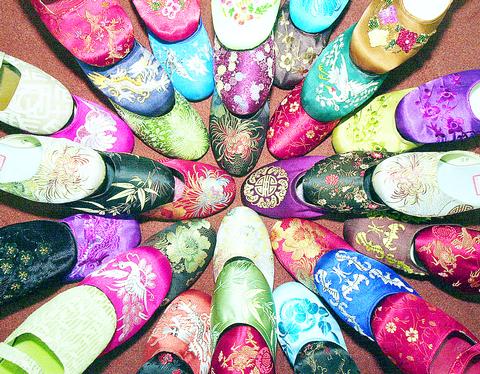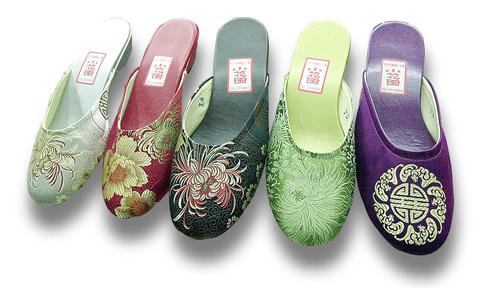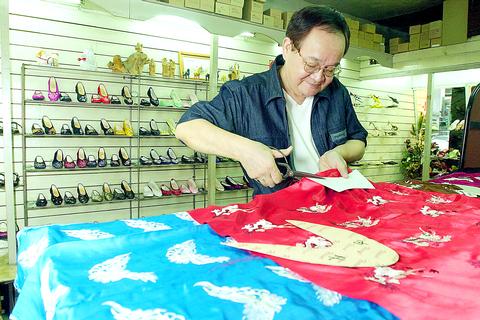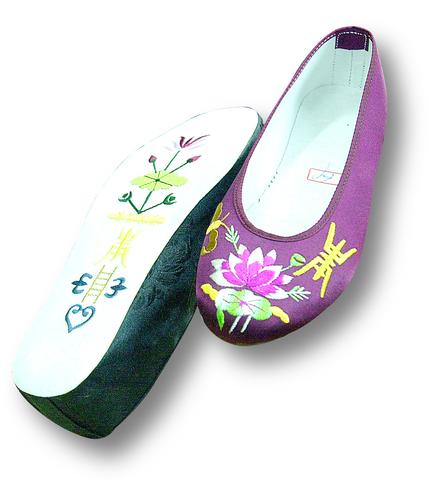The name is Little Garden, but there is no sign of plants nor the scent of flowers in the place -- only shoes.
The Little Garden Shoes Co is an aging shop with 65 years of history. Located in Hsimenting, where shops catering to Taipei's youth sell glossy accessories and sportswear, this old wooden house stands in stark contrast to its neighbors.

The shop doesn't even have a noticeable signboard. Only by walking close by can you spot the old fashioned Chinese calligraphy, Hsiao Hua Yuan (

It's no exaggeration to say that this is a fine garden for shoe-loving female shoppers. It is the world of embroidered shoes.
Entering the Little Garden, the variety of flowers adorning the shoes look no less ravishing than if they were real. Droves of customers, including me, come and linger, pondering which pair to take home. Posing in the mirror, we imagine ourselves as the flowers in the garden.

PHOTO: CHIANG YING-YING, TAIPEI TIMES
"Laoban, do you have this one with blue flowers?" asks one customer.

"No, out of stock. Only in red," the owner relies.
"No, you look good in blue or purple, not red," says another customer.
"Try these. This year's trend is peony or chrysanthemum patterns. The dragon pattern is out of date," the owner tells them.
Some 30 years ago, when Hsimenting was the most prosperous area in Taipei, Little Garden was a favorite shopping spot for the wives of wealthy businessmen or politicians.
And now, thanks to a trend in ethnic and Asian fashions -- so-called Chinese chic -- the garden has again become a hot spot among young women, especially Japanese tourists.
"There are two must-visit-shops for Japanese tourists coming to Taiwan. One is the steamed dumpling place, Din Tai Fong (
As we talk, he's also busy attending to his Japanese customers with his fluent "sales Japanese."
"I heard that the shoes here are all cute and cheap. That's why I came here," said the 29-year-old woman from Japan. She was on a four-day trip to Taipei and showed me her Taiwan guidebook, published by Japanese Earth Walkers, which describes the store as the one and only place for original Shanghai-style embroidered shoes -- most of which are hand-made.
The guidebook is right. "We're the sole surviving embroidered-shoe shop in Taiwan," said the 58-year-old Chen.
The most distinguished products in the store are the 100 percent handmade shoes with a vamp, or upper, of black silk intricately embroidered with a colorful peacock. The inside is padded with soft cotton and hand-sewn to a leather sole. A pair costs NT$1,500.
Chen said these particular shoes are handmade by craftsman over 70 years old, and so in any given month there is usually only one pair available.
Chen is the third-generation owner of Little Garden. He said that the shop was established by his grandfather in Shanghai in 1936. It was located "in the foreigner's concession area, Sima Rd. (
Like many mainlanders, the Chen family moved to Taipei in 1949, during the KMT's retreat to Taiwan.
"Until the 1960s, most Taiwanese wore Japanese-style wooden sandals. People were still poor and our customers were mainly the wealthy," Chen said.
Chen took out another pair of black shoes with simple white and gold embroidery and a sole of suede. "This is a typical in-house shoe. A lot of rich wives would buy this pair to play mah-jong while visiting people's houses. It's a very comfortable shoe to wear when playing mah-jong for a long time," said Chen.
Embroidered shoes grew in popularity during the Chin dynasty, around the time when the chi-pao (
The 1970s were the golden days for Little Garden, when embroidered shoes became very popular. "We received dozens of invoices every day," recalled Chen. At that time, the shop's factory had 50 staffers designing, cutting, sewing and selling the shoes. There were also four other embroidered shoe shops in Hsimenting.
"I remember there was a chi-pao shop right next to Little Garden. I used to first shop at the chi-pao store, choosing the right fabric and design, then go to Little Garden for a matching pair of shoes," said 71-year-old Chang Kwei-chih (張桂芝), a Little Garden customer for some 30 years.
According to Chen, among the shop's devoted customers are KMT chairman Lien Chan's (
Twenty years ago, the slippers provided in China Airline's first class cabin were also embroidered shoes from Little Garden.
The shoes' popularity faded after less expensive plastic shoes became fashionable in the late 1970s. "The market for this kind of shoe is small. It's not waterproof, not very durable and absolutely not made for walking. It's basically a rich person's shoe," Chen said.
Craftsmen capable of making embroidered shoes are also disappearing. There are less than five shoemakers with the skills of the tradition in Taiwan. The needlework skills to produce the shoes are also found less and less these days as it demands a great deal of concentration and is a strain on one's eyesight.
About three years ago, when retro-Chinese style became chic, Chen designed a series of new styles with a modern twist. The toes of the shoes are sharper and the heels a bit higher. The traditional hand-embroidery has largely been replaced by machine work, or often with a pre-embroidered brocade, which cuts-down on labor costs.
"I was the first one to begin using pre-made brocade on shoes," Chen said proudly. These styles have become some of the most popular items in the store.
"I like the style. Most of the shoes maintain the classic, delicate Chinese-style cut. And they're cheap," said another customer.
Prices at Little Garden are very reasonable. A pair of flats cost NT$500, and modern sandals are NT$800. The two Japanese tourists bought two pairs each.
So never mind that you can't walk in them, and never mind that the traditional craftsmanship behind them is waning, as long as the shoes remain fancy, cute and cheap, the Little Garden will remain a favorite spot for born-to-shop. women. The many embroidered shoe shops sprouting up on Shanghai's Nanjing Rd. are evidence of this.
"I was preparing to retire a few years ago. But now who knows, I might continue for another five to 10 years. And maybe open another shop in Shanghai!" Chen said.

May 11 to May 18 The original Taichung Railway Station was long thought to have been completely razed. Opening on May 15, 1905, the one-story wooden structure soon outgrew its purpose and was replaced in 1917 by a grandiose, Western-style station. During construction on the third-generation station in 2017, workers discovered the service pit for the original station’s locomotive depot. A year later, a small wooden building on site was determined by historians to be the first stationmaster’s office, built around 1908. With these findings, the Taichung Railway Station Cultural Park now boasts that it has

Wooden houses wedged between concrete, crumbling brick facades with roofs gaping to the sky, and tiled art deco buildings down narrow alleyways: Taichung Central District’s (中區) aging architecture reveals both the allure and reality of the old downtown. From Indigenous settlement to capital under Qing Dynasty rule through to Japanese colonization, Taichung’s Central District holds a long and layered history. The bygone beauty of its streets once earned it the nickname “Little Kyoto.” Since the late eighties, however, the shifting of economic and government centers westward signaled a gradual decline in the area’s evolving fortunes. With the regeneration of the once

In February of this year the Taipei Times reported on the visit of Lienchiang County Commissioner Wang Chung-ming (王忠銘) of the Chinese Nationalist Party (KMT) and a delegation to a lantern festival in Fuzhou’s Mawei District in Fujian Province. “Today, Mawei and Matsu jointly marked the lantern festival,” Wang was quoted as saying, adding that both sides “being of one people,” is a cause for joy. Wang was passing around a common claim of officials of the People’s Republic of China (PRC) and the PRC’s allies and supporters in Taiwan — KMT and the Taiwan People’s Party — and elsewhere: Taiwan and

Even by the standards of Ukraine’s International Legion, which comprises volunteers from over 55 countries, Han has an unusual backstory. Born in Taichung, he grew up in Costa Rica — then one of Taiwan’s diplomatic allies — where a relative worked for the embassy. After attending an American international high school in San Jose, Costa Rica’s capital, Han — who prefers to use only his given name for OPSEC (operations security) reasons — moved to the US in his teens. He attended Penn State University before returning to Taiwan to work in the semiconductor industry in Kaohsiung, where he